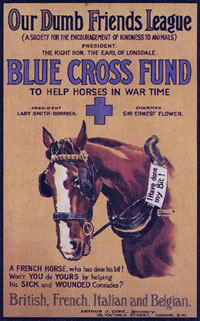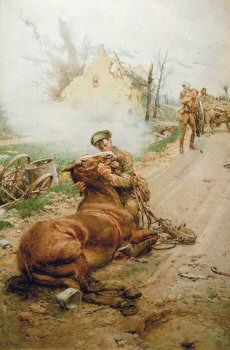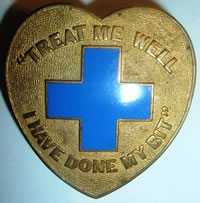Jill Smith, a member of our Society and Executive Committee, also works at Grimsby’s Blue Cross Animal Hospital. Her Talk about the charity’s history and unique Grimsby connection was a well received, giving all much to think about in term of animal care particularly in wartime.
Our Dumb Friends League started in London in 1897 with a focus on the welfare of the many working horses in the capital. By 1901, it had its first ambulance – horse-drawn for the aid of horses. The League offered welfare schemes such as offering, for a small fee (6d), a second horse - ‘trace horses’ - to help pull loads up hills. Cats and dogs were dealt with from early 20th C and they too had special ambulances for transport – the ‘ice-cream’ bike. By 1906 £10,000 bought a building for a first animal hospital for carrying out live veterinary care 24hrs, 7 days a week. The oldest animal hospital of its kind in the world, Victoria Animal Hospital has never closed its doors since opening and continues to treat thousands of pets every year, with treatments ranging from routine neutering to complex operations.
The Balkan War of 1912-1913 saw the first mention of Blue Cross as a particular fund towards animal welfare in the warzone alongside the Red Cross

World War One meant many thousands of horses shipped from UK to war fronts in France. There always had been an Army Veterinary Corps, and initially support from Blue Cross (or more correctly, Our Dumb Friends League ) was turned down but the sheer numbers of horse causalities meant the Corps eventually relented. The French Army, as well as ‘the other side’ also welcomed Blue Cross with open arms. Charity with an animal focus, ensured animal care: mobile forges for the shoeing of horses to prevent lameness; ear muffs to lessen the noise of gun-fire and explosions; fly spray to prevent and relieve bites.
Vet care was basic (as was human care compared with today), but far more than had previously been available. In fact, as with human care, it cannot be denied that veterinarian skill further developed out of wartime need. By the war’s close, there were 80 Blue Cross vets for horses used to transport goods, weapons and soldiers, dogs used as scouts, messengers and searchers, cats to catch vermin and even canaries, used to detect poisonous gas. In total, more than 16 million animals.
The Blue Cross fund carried out much fundraising throughout the world to ensure this animal care continued throughout wartime. Post cards of war hospital images were produced solely for fundraising and the painting Goodbye, Old Man by Italian-born artist Fortunino Matania showing a soldier bidding farewell to his fatally injured horse, was commissioned in 1916. The painting continues to hang in the board room of the animal hospital in Victoria, London.
 Goodbye, Old Man
Goodbye, Old Man
At the war’s end, the charity continued its care with a quarantine and reuniting service. Although many cavalry horses were returned to the UK by the Army, many more, including 285 dogs, were left in France to an uncertain fate. Despite, or because of the atrocities, soldiers of all ranks bonded with their horses and for a long time The Blue Cross received hundreds of letters thanking them for the care and compassion. These letters remain in Blue Cross’s archive. A badge ‘Treat me well – I have done my bit’ was produced to promote horse and dog welfare after the First World War.

Slum clearance schemes between the Wars lead to pets being abandoned because they couldn’t be taken to new homes. The Blue Cross stepped in with a re-homing service.
WW2 saw servicemen with a dilemma of what to do with their beloved pets, so the quarantine kennels were opened again – this time to provide temporary care until owners returned. Bombing raids also brought about animal care need. Animals weren’t allowed in bomb shelters and many lost and frightened animals had to be rescued afterwards, many of which weren’t collected either because owners were displaced or even killed and the re-homing service had to step-in. The Animal War Memorial was opened in Hyde Park, London, in 2004 where Blue Cross holds an annual service to remember the animals that have served in war each Remembrance Sunday.
All through this history, Our Dumb Friends League was the official charity name with Blue Cross reserved for fundraising. In 1955, the charity officially changed its name to the familiar Blue Cross along with the familiar symbol.
The Grimsby connection
It isn’t really recorded as to how and why Blue Cross has been so prominent in Grimsby. The earliest mention is in 1940 when the Lincolnshire Echo appealed for animals to be rescued after bombings but by the end of WW2 Grimsby had 4 clinics staffed by volunteers and by 1951 4300 were being treated annually. Grimsby’s hospital is always keen to hear from any family who has a photograph or recollection from this early period.
In 1959, the Earl of Yarborough opened a new purpose-built Blue-Cross animal hospital in Cleethorpe Road. Built by local builder Henry Rushton, it had room for 48 patients with high-tech equipment built to human-hospital standard, and accommodation for 1 live-in vet. Miss Diana Petchell, daughter of prominent, local councillor and store owner, was the first fully trained superintendent who ran the facility. In 1991 the hospital expanded into next door premises.
A legacy from a Coco Markus provided funds for a new hospital and, continuing as the only Blue Cross hospital outside of the London area, Grimsby was chosen! The brand new hospital and facilities at Coco Markus House, Nelson Street were opened by Princess Anne in 2005. Today, it continues its valuable work for 8000 animals annually with over 70 members of staff and 30+ volunteers. Work includes schools education, pet bereavement and behavioural services and re-homing from a site established at Grimsby Institute’s, Nunsthorpe Campus in In 2015. The Grimsby operation costs £2 million every year – towards which is the latest service: a fundraising shop dedicated to selling donated items from grateful owners and others.
Jill Smith was thanked for her interesting Talk about this well-known establishment in Grimsby and one which we should all be justifiably proud.
SM
Further information:
https://www.bluecross.org.uk/grimsby
https://www.bluecross.org.uk/historic-gallery
National Army Museum Army horse care in the First World War https://www.nam.ac.uk/explore/british-army-horses-during-first-world-war

